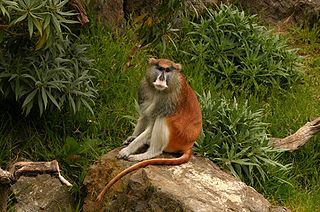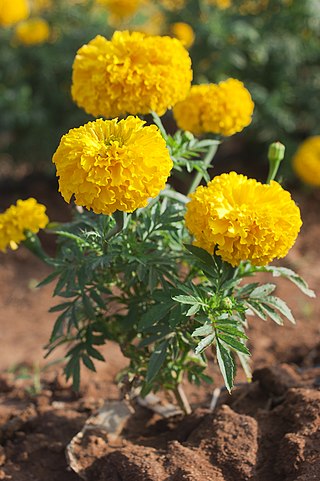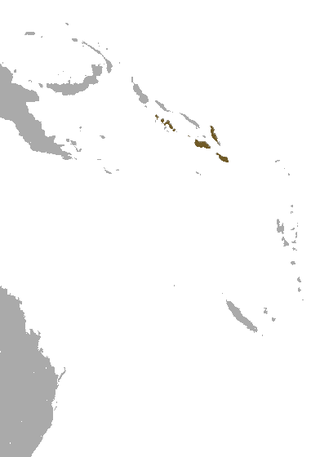
Genus is a taxonomic rank used in the biological classification of living and fossil organisms as well as viruses. In the hierarchy of biological classification, genus comes above species and below family. In binomial nomenclature, the genus name forms the first part of the binomial species name for each species within the genus.

Cissa is a genus of relatively short-tailed magpies, sometimes known as hunting cissas, that reside in the forests of tropical and subtropical southeast Asia and adjacent regions. The four species are quite similar with bright red bills, primarily green plumage, black mask, and rufous wings.

Erythrocebus is a genus of Old World monkey. All three species in this genus are found in Africa, and are known as patas monkeys. While previously considered a monotypic genus containing just E. patas, a 2017 review argued that, based on morphological evidence and heavy geographic separation between taxa, E. patas should be split back into distinct species as recognised in the 19th century.

Tagetes is a genus of 50 species of annual or perennial, mostly herbaceous plants in the family Asteraceae. They are among several groups of plants known in English as marigolds. The genus Tagetes was described by Carl Linnaeus in 1753.
The Deferribacteraceae are a family of gram-negative bacteria which make energy by anaerobic respiration.

The genus Blarina, commonly called short-tailed shrews, is a genus of relatively large shrews with relatively short tails found in North America.

Theobroma is a genus of flowering plants in the mallow family, Malvaceae, that is sometimes classified as a member of Sterculiaceae. It contains roughly 20 species of small understory trees native to the tropical forests of Central and South America.

Schinopsis is a genus of South American trees in the family Anacardiaceae, also known by the common names quebracho, quebracho colorado and red quebracho. In Brazil it is known as baraúna or braúna.
Vernaya is a genus of rodent in the subfamily Murinae from southern China and northern Burma. It contains a four extant species, the red climbing mouse, V. foramena, V. meiguites, V. nushanensis, and several extinct species, all described by Zheng in 1993, namely Vernaya prefulva, V. pristina, V. giganta and V. wushanica. The genus is named after Arthur Stannard Vernay who collected the specimen of V. fulva on an expedition to Burma with Charles Suydam Cutting.

Fardoulis's blossom bat is a species of bat in the Pteropodidae family. It is endemic to the Solomon Islands. Its natural habitat is subtropical or tropical moist lowland forests. It is named after Emmanuel Fardoulis.
The Synergistota is a phylum of anaerobic bacteria that show Gram-negative staining and have rod/vibrioid cell shape. Although Synergistota have a diderm cell envelope, the genes for various proteins involved in lipopolysaccharides biosynthesis have not yet been detected in Synergistota, indicating that they may have an atypical outer cell envelope. The Synergistota inhabit a majority of anaerobic environments including animal gastrointestinal tracts, soil, oil wells, and wastewater treatment plants and they are also present in sites of human diseases such as cysts, abscesses, and areas of periodontal disease. Due to their presence at illness related sites, the Synergistota are suggested to be opportunistic pathogens but they can also be found in healthy individuals in the microbiome of the umbilicus and in normal vaginal flora. Species within this phylum have also been implicated in periodontal disease, gastrointestinal infections and soft tissue infections. Other species from this phylum have been identified as significant contributors in the degradation of sludge for production of biogas in anaerobic digesters and are potential candidates for use in renewable energy production through their production of hydrogen gas. All of the known Synergistota species and genera are presently part of a single class (Synergistia), order (Synergistiales), and family (Synergistaceae).
Gonioglyptus is an extinct genus of trematosaurian temnospondyl within the family Trematosauridae. It is known from the Early Triassic Panchet Formation of India. It contains two species: G. longirostris and G. fragilis. The species G. kokeni from Pakistan has since been reclassified into Aphaneramma.

Nebria is a genus of ground beetles native to the Palearctic, the Near East and North Africa. There are more than 500 described species in Nebria.
Nitrospirota is a phylum of bacteria. It includes multiple genera, such as Nitrospira, the largest. The first member of this phylum, Nitrospira marina, was discovered in 1985. The second member, Nitrospira moscoviensis, was discovered in 1995.

Carabinae is a subfamily of ground beetles in the family Carabidae. There are about 10 genera and more than 1,400 described species in Carabinae. The Carabinea include 2 tribes, the Cychrini Laporte, 1834 and Carabini Latreille, 1802. The Carabini Latreille is divided into 2 sub-tribes, the Carabina Latreille, 1802 and Ceroglossina Vacher de Lapouge, 1927.
The Solirubrobacterales are an order of Actinomycetota.
Chloroflexales is an order of bacteria in the class Chloroflexia. The clade is also known as filamentous anoxygenic phototrophic bacteria (FAP), as the order contains phototrophs that do not produce oxygen. These bacteria are facultative aerobic. They generally use chemotrophy when oxygen is present and switch to light-derived energy when otherwise. Most species are heterotrophs, but a few are capable of photoautotrophy.

Botucaraitherium is an extinct genus of prozostrodontian cynodonts from the early Norian Riograndia Assemblage Zone in the Candelária Formation of the Paraná Basin in southeastern Brazil. It is known from a single type species, Botucaraitherium belarminoi. The genus name is derived from the Botucaraí Hill, which dominates the landscape of Candelária, Rio Grande do Sul. The species epithet honors Belarmino Stefanello, a volunteer at the Museu Municipal Aristides Carlos Rodrigues, who found the fossil.
Paraperipatus is a genus of velvet worms in the family Peripatopsidae. The number of legs vary within species as well as among species in this genus and can range from as few as 21 pairs up to 27 pairs in males and 29 pairs in females. The maximum number of leg pairs recorded in this genus (29) is also the maximum number of leg pairs found in the family Peripatopsidae. This genus exhibits matrotrophic viviparity, that is, mothers in this genus retain eggs in their uteri and supply nourishment to their embryos, but without any placenta. Species in this genus are found in New Guinea and Maluku, Indonesia.












